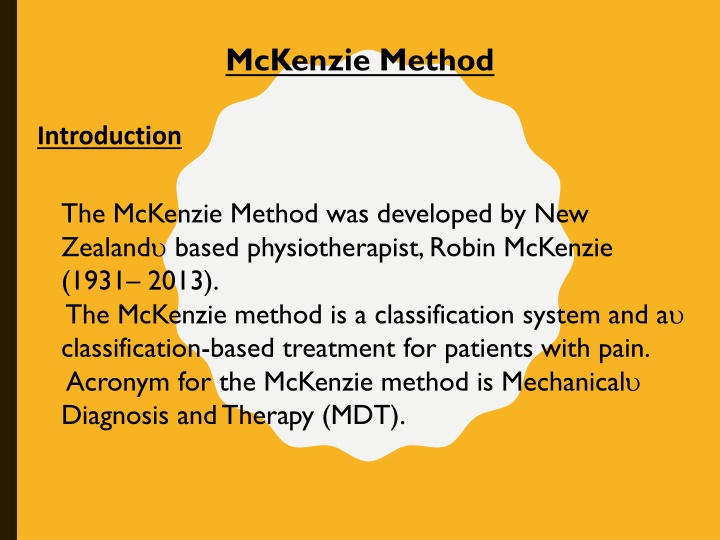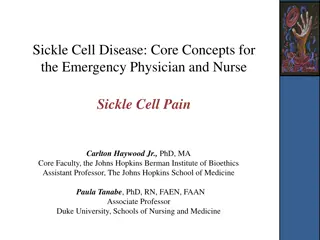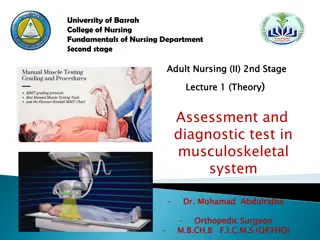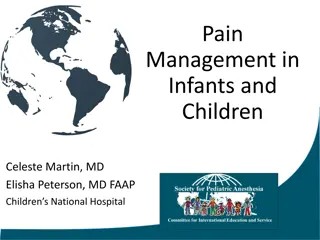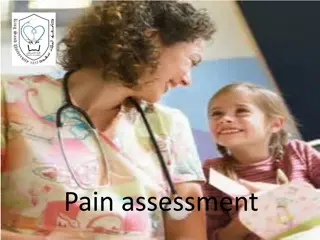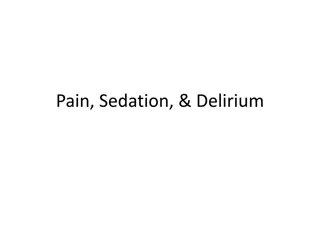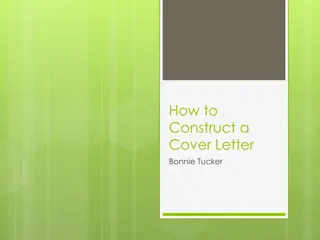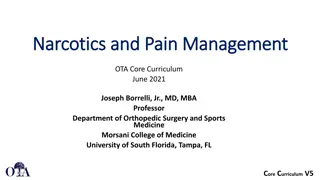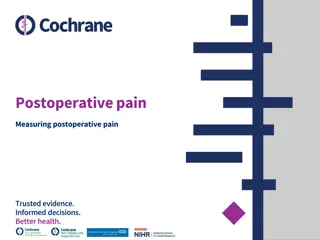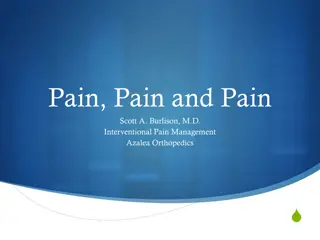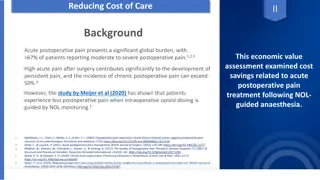The McKenzie Method for Pain Management
The McKenzie Method, developed by physiotherapist Robin McKenzie, is a classification-based system for treating pain. It involves assessment, treatment, and prevention steps, with an emphasis on centralizing symptoms and promoting pain reduction. The method categorizes pain into three syndromes - Posture Syndrome, Dysfunction Syndrome, and Derangement Syndrome - each requiring specific management approaches. The goal is to reduce pain, centralize symptoms, and achieve complete recovery through targeted therapies and patient education.
Download Presentation

Please find below an Image/Link to download the presentation.
The content on the website is provided AS IS for your information and personal use only. It may not be sold, licensed, or shared on other websites without obtaining consent from the author.If you encounter any issues during the download, it is possible that the publisher has removed the file from their server.
You are allowed to download the files provided on this website for personal or commercial use, subject to the condition that they are used lawfully. All files are the property of their respective owners.
The content on the website is provided AS IS for your information and personal use only. It may not be sold, licensed, or shared on other websites without obtaining consent from the author.
E N D
Presentation Transcript
McKenzie Method Introduction The McKenzie Method was developed by New Zealand based physiotherapist, Robin McKenzie (1931 2013). The McKenzie method is a classification system and a classification-based treatment for patients with pain. Acronym for the McKenzie method is Mechanical Diagnosis and Therapy (MDT).
Terminology The McKenzie method consists of 3 steps: 1. Assessment 2. Treatment and 3. Prevention.
The evaluation is received using repeated movements and sustained positions. With the aim to elicit a pattern of pain responses, called centralization, the symptoms of the lower limbs and lower back are classified into 3 subgroups: derangement syndrome, dysfunction syndrome and postural syndrome.
Principles Kyphotic antalgic management: extension principle Acute coronal antalgic management: lateral flexion- then-extension principle Acute lordotic antalgic management: Flexion principle
Aims The aims of the therapy are: reducing pain, centralization of symptoms (symptoms migrating into the middleline ofthe body)and The complete recovery of pain.
The Three Syndromes According to McKenzie, Pain of spinal origin can be classified into 3 syndromes Posture Syndrome Dysfunction Syndrome Derangement Syndrome
Posture Syndrome Refers to pain which occurs due to a mechanical deformation of normal soft tissue from prolonged end range loading of periarticular structures. The pain arises during static positioning of the spine: for example sustained slouched sitting. The pain disappears when the patient is moved out of the static position.
Treatment : patient education, correction of the posture by improving posture by restoring lumbar lordosis, avoiding provocative postures and avoid prolonged tensile stress on normal structure
Dysfunction Syndrome Refers to pain which is a result of mechanical deformation of structurally impaired tissues like scar tissue or adhered or adaptively shortened tissue The pain arises at the end range of a restricted movement.
Treatment Mobilizing exercises in the direction of the dysfunction or in the direction that reproduces the pain. The aim is to remodel that tissue, which limits the movement, through exercises so that it becomes pain-free over time
Derangement Syndrome Is the most prevalent treatment classification. Refers to pain which is caused by a disturbance in the normal resting position of the affected joint surfaces. This syndrome is classified in two groups: Reducible irreducible
1. Irreducible Derangement The criteria for derangement are present. No strategy is capable to produce a permanent change in symptoms 2. Reducible Derangement Shows one direction of repeated movement which decreases or centralizes referred symptoms = preferred direction. Shows also an opposite repeated movement characterized by production or increase or distal movement of the symptoms.
Treatment examination of the patient s symptomatic and mechanical response to repeated movements or sustained positions because the chosen treatment depends on the clinically induced directional preference.
Directional Preference It describes the situation when movements in one direction will improve pain and the limitation of range, whereas movements in the opposite direction cause signs and symptoms to worsen 1. Centralization 2. Peripheralization
Centralization Describes the phenomenon in which limb pain emanating from the spine is progressively abolished in a distal to proximal direction in response to therapeutic loading strategies If back pain only is present this is reduced and then abolished.
Peripheralization Describes the phenomenon by which pain emanating from the spine spreads distally into or further into the limb as a result loading strategies. If pain is produced in the limb, spreads distally or increases distally and remains worse the loading strategy should be avoided.
Assessment History- mechanical / non mechanical pain Posture Neurological examination Examination of movement Dynamic mechanical evaluation Static mechanical evaluation palpation
Aims of history-taking By using the form and the appropriate questioning technique, ideally at the end of the history-taking the following will have been obtained: Site of the back pain: central / symmetrical, or unilateral / asymmetrical; if unilateral is the pain in the back or thigh, or referred below the knee The stage of the disorder - acute / sub-acute / chronic The status of the condition - improving / unchanging / worsening Identification of 'red flags' or contraindications
Type of pain Acute - less than seven days Sub-acute - between seven days and seven weeks' duration Chronic - more than seven weeks' duration.
Technique Physical therapists trained in the McKenzie method will prescribe exercises in association with the centralization phenomenon mentioned above. Given that most people classify with a directional preference for spinal extension, this will be the direction of their prescribed exercises.
Prone position lying flat (patient lies flat on their stomach) Prone position propped on elbows (patient lies flat on their stomach and props themselves onto their elbows with the spine in extension) Prone position propped on hands (patient lies flat on their stomach and props themselves onto their hands with elbows in full extension, with the spine in extension) Standing lumbar extension (patient stands upright with feet shoulder-width apart, and puts hands on the lower back while extending the spine)
Indication 1. McKenzie exercises are prescribed to patients who exhibit the centralization phenomenon of back pain. 2. Exercises are indicated based on directional preference, and their indication is the same direction of directional preference. 3. For example, is a patient exhibits a directional preference for spinal extension (most common), the exercises performed will be in spinal extension.
Contra-indications If in the examination no position or movement can be found which reduces the presenting pain, the patient is unsuited for mechanical therapy. Saddle anesthesia and bladder weakness. Patients who exhibit signs of extreme pain. Developmental or acquired anomalies of bone structures which may lead to weakness or instability of mechanical articulations. Architectural faults should be excluded from mechanical therapy. E.g. spondylolisthesis
